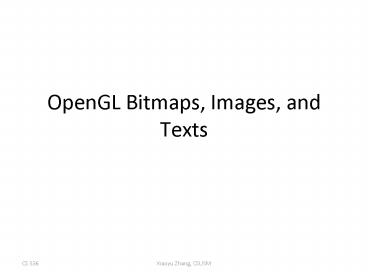OpenGL Bitmaps, Images, and Texts - PowerPoint PPT Presentation
1 / 13
Title:
OpenGL Bitmaps, Images, and Texts
Description:
... data for each row of the image begin on a 4-byte boundary ... You can find on-line descriptions and loaders for a lot of image file formats, e.g. imagemagick. ... – PowerPoint PPT presentation
Number of Views:163
Avg rating:3.0/5.0
Title: OpenGL Bitmaps, Images, and Texts
1
OpenGL Bitmaps, Images, and Texts
2
Bitmap
- OpenGL provides the basic functions of drawing 2D
raster graphics -- texts and images - A bitmap is a rectangular binary array for
pixels. It is often used as mask or drawing
texts. When you draw a bitmap, - A pixel will be drawn with the current color if
its bit in the map 1 - Nothing is drawn if its bit 0
3
Current Raster Position
- The current raster position is the origin where
the next bitmap/image is to be drawn. It is set
by calling - glRasterPos234sifd(x, y, z, w)
- Z 0 and w 1 for glRasterPos2()
- The raster position is transformed in the same
way as coordinates in glVertex(). - If the transformed point is clipped out, the
current raster position is invalid. - Get the current raster position
- GLfloat pos4
- glGetFloatv(GL_CURRENT_RASTER_POSITION, pos)
4
Drawing the Bitmap
- glBitmap() draws a bitmap to the framebuffer
relative to the current raster position. - glBitmap(width, height, x0, y0, xi, yi, bitmap)
- width, height width and height of the bitmap
- x0, y0 origin of the bitmap relative to the
current raster position. - xi, yi the x and y increments to the raster
position after the bitmap is drawn - bitmap a byte array storing the bitmap
- Example write a letter A
- glOrtho(0.0f, 800, 0.0, 600, -1.0, 1.0)
- glTranslatef(rand()800, rand()600, 0)
- glRasterPos2i(0, 0)
- glBitmap(16, 16, 0.0, 0.0, 0.0, 0.0, letterA)
5
Using Images
- Images have more information for a pixel, e.g.
RGB values - glDrawPixels() writes a rectangular array of
pixels into the framebuffer at the current raster
position - glDrawPixels(width, height, format, type,
pixels) - format indicates the kind of pixel data elements
- GL_COLOR_INDEX
- GL_RGB
- GL_RGBA
- GL_DEPTH_COMPONENT
- type indicates the data type of each element
- GL_BYTE
- GL_UNSIGNED_BYTE
- GL_INT
- GL_FLOAT
- pixels an array of pixel data elements
6
Reading Pixels
- You may read a rectangular array pixels from the
framebuffer to the main memory - glReadPixels(x, y, width, height, format, type,
pixels) - x, y lower left corner of the framebuffer
rectangle - width, height width and height of the rectangle
- format the same as glDrawPixels()
- type the same as glDrawPixels()
- pixels an array of pixel data
- Reading back from framebuffer is slow!
- Example
- GLubyte imgData new GLubytewh3
- glReadPixels(0, 0, w, h, GL_RGB,
GL_UNSIGNED_BYTE, imgData)
7
Copying Pixels
- Copy pixels from one framebuffer rectangle to
another - glCopyPixels(x, y, width, height, buffer)
- buffer specifying the framebuffer that is used
- GL_COLOR
- GL_DEPTH
- GL_STENCIL
- The buffer rectangle specified by (x, y, width,
height) is copied to a rectangle at the current
raster position. - For all three functions, the exact conversion of
data going to or from the framebuffer depend on
the modes in effect at the time
8
Magnifying, Reducing, or Flipping
- OpenGL allows you to arbitrarily magnify, reduce,
or even flip (reflect) an image by using
glPixelZoom() - glPixelZoom(xZoom, yZoom)
- glPixelZoom(-1.0f, -1.0f) // flip image
horizontally and vertically - glPixleZoom(0.5f, 0.5f) // reduce image size
- glPixelZoom(2.0f, 2.0f) // magnify image size
- Pixel Zoom is applied to both glDrawPixels() and
glCopyPixels() - Application as a magnifying glass or a sniper gun
for games
9
Managing Pixel Storage
- There are a lot of details of how to store pixels
data in main memory, such as alignments,
byte-ordering etc.. You can control the pixel
storage mode using - glPixelStoreif(pname, param)
- pname GL_PACK_ALIGNMENT or GL_UNPACK_ALIGNMENT
- Packing refers to the way that pixel data is
written to main memory, e.g. glReadPixels - Unpacking refers to the way that pixel data is
read from memory, e.g. glTexImage2D - param 1, 2, 4, 8
- Default 4 means the data for each row of the
image begin on a 4-byte boundary - Several other parameters available, check OpenGL
programming guide
10
Image formats
- There are hundreds of different image formats
available. I wont cover any particular format. - You can find on-line descriptions and loaders for
a lot of image file formats, e.g. imagemagick.
11
Bitmap Fonts
- A set of bitmaps will generated as display lists,
and drawn using glCallLists - OpenGL doesnt directly support displaying text.
We need to use platform specific functions. - glutBitmapCharacter(void font, int character)
- font Bitmap font to use, including
GLUT_BITMAP_8_BY_13, GLUT_BITMAP_9_BY_15,
GLUT_BITMAP_TIMES_ROMAN_10, GLUT_BITMAP_TIMES_ROMA
N_24, GLUT_BITMAP_HELVETICA_10,
GLUT_BITMAP_HELVETICA_12, GLUT_BITMAP_HELVETICA_18
- character Character to render
- Read textbook for displaying fonts with wgl
extensions.
12
Drawing bitmap fonts
- char str OpenGL Bitmap Fonts!
- //Set matrices for ortho
- //Print text
- glRasterPos2f(-0.5f, 0.0f)
- for(unsigned int i0 iltstrlen(str) i)
- glutBitmapCharacter(GLUT_BITMAP_HELVETICA_18,
stri) - //reset matrices
- glPopMatrix()
- glMatrixMode(GL_PROJECTION)
- glPopMatrix()
13
Setting Raster Position for Text
- Set the raster position in the 3D space. Remember
Modelview and Projection transformations are
applied to the raster position. - glMatrixMode(GL_PROJECTION)
- glPushMatrix()
- glLoadIdentity()
- gluOrtho2D(-1.0f, 1.0f, -1.0f, 1.0f)
- glMatrixMode(GL_MODELVIEW)
- glPushMatrix
- glLoadIdentity()
- glRasterPos2f(-0.5f, 0.0f)
- A point on the near plane.































